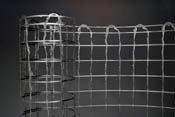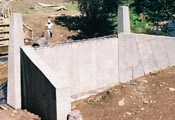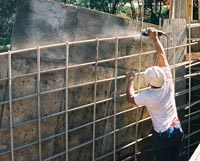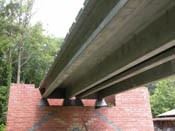COMPOSITES AND CONCRETE
The benefits of composite materials are well established in concrete reinforcement and construction.
Inexpensive and versatile, concrete is simply the best building material for many applications. The issue is how to make concrete stand up to environmental and structural loads for long-term performance. A true composite, concrete typically consists of gravel and sand — aggregate — bound together in a matrix of fine Portland cement, with metal rebar usually incorporated for strength. It performs admirably under compression, but tends to be brittle and somewhat weak in tension. Tensional stress as well as plastic shrinkage during cure leads to cracks, which invite moisture ingress that eventually leads to corrosion of the embedded metal and eventual loss of integrity as the metal deteriorates.
Fiber-reinforced polymer (FRP) composites long have been envisioned as an enabling material for improved concrete performance. The American Concrete Institute (ACI) and other groups, such as the Japan Society for Civil Engineers, have been instrumental in developing specifications and test methods for composite reinforcing materials, many of which are accepted and well-established today in concrete construction. "In addition to design guideline documents, we now have the test methods," says John Busel, chairman of the ACI's Committee 440, formed in 1990 to provide engineers and designers with information and direction for composite materials. Test methods are outlined in ACI 440.3R-04. (This and other significant published documents related to composite reinforcement of concrete can be found in the accompanying sidebar, "Concrete Design Guides") "We're also steadfastly working on a revision of our 1996 state-of-the-art report, to update concrete practitioners on the many new applications and emerging market opportunities," says Busel.
Composite rebar and reinforcing grids continue to find use in a number of applications. More recently, products have been developed and applications are beginning to proliferate for fiber-reinforced concrete, a material that uses steel or polymer fibers as reinforcement in pavements, floor slabs and precast parts.
COMPOSITE REBAR: ESTABLISHED TECHNOLOGY
Over the past 15 years, composite rebar has gone from experimental prototype to effective replacement for steel on many projects, particularly with rising steel prices. "Fiberglass rebar is commonly used, and it's a very competitive market," says Doug Gremel, director of nonmetallic reinforcing for Hughes Bros. (Seward, Neb.), an established maker of rebar products. "The industry's state of knowledge about the material is immensely better than 10 years ago."
For some construction projects, like magnetic resonance imaging (MRI) facilities in hospitals, or the approaches to toll road booths that employ radio frequency identification (RFID) tag technology for identifying pre-paid customers, composite rebar is the only choice. Steel rebar can't be used, because it interferes with electromagnetic signals. In addition to electromagnetic transparency, composite rebar also offers exceptional corrosion resistance, light weight — about one-fourth the weight of steel — and thermal insulation, because it resists heat transfer in building applications. The two largest manufacturers are Hughes and Pultrall (Thetford Mines, Canada).
Composite rebar is typically pultruded, using E-glass fiber rovings and vinyl ester resin, with standard forming techniques. Hughes' Aslan products are made with a helical wrap to create an undulating profile, while Pultrall's V-ROD bar is smooth. Both have an outer sand coating, applied during manufacture, to create a rough surface for optimum bond adhesion. According to Gremel, a high-quality vinyl ester resin is needed, coupled with the correct fiber sizings, to achieve the best corrosion properties and resistance to the high alkali in the Portland cement, as well as a tenacious bond.
Because fiberglass mechanical properties are different than steel, concrete structure design with composite rebar is developed using ACI 440.1R-03, Guide for the Design and Construction of Concrete Reinforced with FRP Bars. The Guide addresses flexure, serviceability, creep rupture and fatigue, in addition to shear and detailing for stirrups, says Busel. Both Hughes and Pultrall are members of the FRP Rebar Manufacturers Council, under the umbrella of the American Composites Manufacturers Assn. (ACMA) and are involved with ACI in developing minimum performance standards for rebar. While it is true that composite rebar can't be bent at the job site to meet unexpected conditions, Gremel says it's a non-issue. "Epoxy-coated steel bars can't be bent either, without breaking the epoxy coating," he states. "We can pre-bend fiberglass bars during manufacturing to an engineer's design, according to a detailed schedule, which is how it should be done." With the release of the new test methods for concrete with composite rebar, owners and designers now have assurance that the structure will perform as anticipated. Gremel notes that the test document will be converted to an ASTM standard.
Pultrall V-ROD is distributed in the U.S. exclusively by Concrete Protection Products Inc. (CPPI, Dallas, Texas). CPPI's president Sam Steere reports several recent projects employing V-ROD, including a new bridge that spans U.S. highway I-65 in Newton County, Indiana. The 58m/191-ft long, three-span bridge is 10.5m/34.5 ft wide with a reinforced concrete deck that sits atop steel I-beams, that are supported on concrete piers. The 203 mm/8-inch thick concrete deck is reinforced with epoxy-coated steel rebar in the lower half, but corrosion-resistant V-ROD composite bar is used in the upper half, where the potential for contact with deicing salts is greatest. Two sizes of composite bar were placed, each on 152 mm/6-inch centers — #5 bar (16-mm/0.625-inch diameter) in the transverse direction and #6 (19-mm/0.75-inch diameter) running in the longitudinal direction. The entire structure was instrumented with optical fiber sensors by researchers at Purdue University, for ongoing evaluation of the deck's performance via a remote connection. It's the first use of composite bar in a bridge deck application by the Indiana Department of Transportation, says Steere.
Hughes Bros. Aslan 100 fiberglass bars were recently installed in a site-cast concrete bridge in Morrison, Colo., built by the Colo. Dept. of Transportation (CDOT) in cooperation with the City and County of Denver Parks and Recreation Dept. The 13.8m/45-ft long bridge, which spans Bear Creek, used fiberglass rebar in the footings, abutments, wing walls, parapets and a curved poured-in-place concrete arch. A one-piece, all-composite deck that sits atop the concrete arch was fabricated by Kansas Structural Composites (Russell, Kan.). A number of different rebar sizes were incorporated into the cast elements, including #5, #6 and #7 (19-mm/0.75-inch diameter). Many bent stirrups and unique shapes were required to achieve the detailed design, Gremel points out, adding that all were fabricated at the factory prior to shipment. CDOT engineer Mark Leonard says the state has had good success with composite rebar in past projects and selected Aslan because Hughes submitted the lowest bid. Although the deck gets minimal traffic at low speeds, Leonard says the bridge designer, Parsons Brinkerhoff (Denver, Colo.), followed all ACI design guidelines and used the new ACI440.3R-04 testing methods for certifying the materials.
The composite rebar market is expected to become even more competitive as a new material — basalt fiber — gains a foothold. Sudaglass Fiber Technology (Houston, Texas), a basalt fiber producer with facilities in Russia and the Ukraine, has broken ground on a U.S. production facility in northern Texas, says Sudaglass' executive VP Graham Smith. Basalt/epoxy rebar is currently being pultruded in the Ukraine, and is in the process of being certified for U.S. construction, according to Smith.
With a density only slightly greater than typical glass fibers, the company's basalt fibers have a much wider thermal range of -260°C to 982°C (-436°F to 1850°F) compared to a nominal range of -60°C to 650°C (-76°F to 1202°F) for glass — and a melt point of 1450°C (2642°F), making basalt useful in applications that demand fire resistance. In addition, Smith notes that the material demonstrates excellent resistance to the alkali content in concrete without resort to the special sizings used to protect glass fibers.
Whatever the reinforcement choice, composite rebar is expected to have wide appeal among project decision makers. "The bottom line is, a good engineer or designer is trying to solve the corrosion problem," concludes Gremel. "For a 5 to 7 percent greater cost in project materials, you achieve 10 to 20 years longer life for the structure with this product."
COMPOSITE GRIDS IN PRECAST PANELS: HIGH POTENTIAL
Since CT first reported on the use of fiber-reinforced polymer grids in precast concrete construction panels ("Composite Solutions Meet Growing Civil Construction Demands," CT August 2002, p. 40), the market has witnessed significant growth, says Busel. "This application is huge," he contends. "There's tremendous potential."
The charge is being led by AltusGroup, a consortium of five precast concrete manufacturers and reinforcement producer TechFab LLC (Anderson, S.C.), formed specifically to promote CarbonCast technology in which the latter's C-GRID carbon fiber/epoxy grids replace traditional steel grid or rebar in precast structures as secondary reinforcement. TechFab is a 50/50 joint venture of Hexcel (Dublin, Calif.) and Chomarat Group (Le Cheylard, France). So far, AltusGroup members include Oldcastle Precast (Edgewood, Md.), HIGH Concrete Structures (Denver, Pa.), two precasters owned by Cretex Companies (Elk River, Minn.) and Metromont Prestress (Greenville, S.C.), but new members are likely to be added due to growing sales volume, says John Carson, TechFab's director of commercial development and program leader for C-GRID technology.
A variety of CarbonCast products are offered by AltusGroup, including both structural and nonstructural insulated wall panels and architectural cladding. C-GRID typically replaces secondary steel wire mesh reinforcing elements — conventional steel rebar is still used for primary reinforcement in most cases. C-GRID is made in an efficient, proprietary quasi-weaving process that aligns superimposed warp and weft large-tow carbon fibers wet out with a rapid cure epoxy, in an open structure. Grid openings vary in size from 25.4 mm to 76 mm (0.25 inch to 3 inches), depending on panel strength requirements, concrete type and aggregate size. During the manufacturing process, the grid is given a rough surface that enhances bond strength between the grid and cured concrete. Grids, featuring glass, aramid or polymer fibers in combination with any one of a variety of resins, are also available, in TechFab's MeC-GRID product line. Carbon and noncarbon grids both find use in other applications, such as decorative elements, cast-in-place concrete and repair/rehabilitation.
The advantages of CarbonCast panels are significant, says Carson. C-GRID is much lighter and has nearly seven times greater tensile properties than steel. Cracking due to cure shrinkage is greatly reduced, and C-GRID won't corrode, which eliminates the often unsightly surface staining that occurs on concrete panels with steel grids. Its corrosion resistance permits the use of as little as 6.35 mm/0.25 inch of concrete cover, while up to 76.2 mm/3 inches of cover may be required to shield steel grid from moisture. Therefore, panel weight can be reduced by as much as 66 percent, compared to conventional precast. Lighter panels allow for lower overall wall weight, which in turn requires less substantial steel substructure, resulting in significantly lower construction costs. C-GRID also is thermally nonconductive, so the panel's insulation value isn't compromised. Further, openings can be cut in the panels at the job site with a power saw, which isn't possible with a steel grid. All of these benefits translate to lower transportation, erection and superstructure costs for more efficient construction.
Over 3 million ft2 of CarbonCast panel products have been sold to date and demand is so high that TechFab recently announced major expansion plans. A new plant will house an additional grid manufacturing line that, according to Carson, should be operational by October of this year. The announcement closely followed the company's announced multiyear agreement with Zoltek Corp. (St. Louis, Mo.), the supplier of the Panex 35 large-tow fiber used in C-GRID. According to Carson, the agreement will ensure a consistent supply for C-GRID during initial product launch years. "Zoltek has been our primary fiber supplier and advocate from day one of this project," he notes.
The precast panels have been used in projects as diverse as movie theatres, churches and parking garages. A recent project was the 332,000-ft2 Cardinal Health office/warehouse complex near Baltimore, Md. CarbonCast panels up to 15.5m/51-ft long were cast to form the two-story building's vertical exterior walls. Each panel is a sandwich construction featuring 152 mm/6 inches of foam insulation (achieving R-16 insulation value) between facesheets consisting of a 50-mm/2-inch thick outer wythe (concrete layer) and a 100-mm/4-inch thick inner wythe, C-GRID placed perpendicular to the panel faces connects inner and outer wythes, providing shear reinforcement.
"We're moving into high gear with this concept," says Carson. "We're adding new products to meet the application growth."
FIBER-REINFORCED CONCRETE: COMING ON STRONG
The use of short fibers in concrete for improved properties has been an accepted technology for decades — even centuries, considering that in the Roman Empire structural mortars were reinforced with horsehair. Fiber reinforcements increase concrete's toughness and ductility (the ability to deform plastically without fracturing) by carrying a portion of the load in the case of matrix failure and by arresting crack growth. Dr. Victor Li of the University of Michigan has researched the properties of high-performance fiber-reinforced cementitious composites, a very high-performance subset of fiber-reinforced concrete, and he believes that acceptance of the material will grow, as long as performance, low cost and easy execution are maintained.
"Using this material may lead to elimination of shear reinforcing bars, resulting in a reduction of material and labor costs," says Li. "A thinner structure reduces material volume and dead load, and makes transportation easier. These overall cost reductions can easily justify the cost of the fiber-reinforced material."
Official recognition of fiber-reinforced concrete has spurred publication of standards and guidelines for its use over the past five years (see CT July/August 2001, p. 44). Since that time, commercial applications have burgeoned.
Building materials giant Lafarge SA (Paris, France) has promoted its ultrahigh-performance fiber-reinforced concrete material, trade marked Ductal, for nearly ten years, targeting a wide variety of civil infrastructure and architectural applications. Ductal is a mixture of Portland cement, silica fume, quartz flour, fine silica sand, plasticizers, water and either steel or organic fibers, typically 12 mm/0.5 inch in length. Vic Perry, VP/general manager for Ductal, says the combination of fine powders, selected for relative grain size, creates maximum compaction during cure, resulting a complete absence of continuous porosity, which virtually eliminates moisture ingress and potential corrosion of steel fibers. To be on the safe side, polyvinyl alcohol (PVAL) fibers are typically specified for architectural or decorative applications, to preclude any possibility of surface staining which might occur with rusting steel fibers and eliminate abrasiveness where human contact is a concern. The materials are sold in bulk bags to precasters or concrete ready-mix suppliers.
"The addition of the fibers makes the material deform in a ductile manner and support tensile loads," says Perry. "The fibers provide toughness and improved micro-structural properties."
Depending on the type of fiber used, the compressive strength of Ductal ranges from 150 MPa to 200 MPa (21,750 psi to 29,000 psi), compared to standard concrete's 15 MPa to 50 MPa (2,175 psi to 7,250 psi). Tested flexural strength is as high as 40 MPa/5,800 psi, says Perry. Ductal reinforced with Lafarge's Forta steel fibers has been used for precast construction and in several prestress bridge beam applications. In Saint Pierre La Cour, France, a 20m/65-ft long vehicular bridge was designed with 10 Ductal I-beam girders supporting a traditional, cast-in-place 170-mm/6.5-inch thick rebar-reinforced concrete deck. The precast girders, which contain no rebar, are 600-mm/24-inches deep and were prestressed with 13-mm/0.5-inch steel strand cables, placed in the lower flange. Tension is applied to the strands before the Ductal is poured into the beam form. Once the concrete covers the strands and material has begun to cure, they are cut, which in effect puts compression stress on the concrete mixture.
When you subject a prestressed beam to any bending, explains Perry, it doesn't experience tensional stress but instead "uncompresses," greatly improving performance. Because of Ductal's strength, the beams don't require rebar, which significantly cuts per-foot weight.
Ductal structures shaped in cross-section like the Greek capital letter "Π" (essentially a box beam without a lower flange) are functioning as both deck and girders on an experimental bridge installed on a test track at the U.S. Federal Highway Authority's (FHWA) Turner Fairbank Laboratory, to investigate the design's suitability for future highway construction. The "Π" girder/deck is designed to withstand American Association of State Highway and Transportation Officials (AASHTO) HL-93 load configurations.
"The Ductal beams allow longer spans for the same beam weight," says Perry. "Eventually, we'll see fiber-reinforced concrete in beams and bridge decks."
SI Concrete Systems. (Chattanooga, Tenn.) is a manufacturer of fiber reinforcement for concrete. SI offers Novomesh, Fibermesh and other fiber products that are used as an alternate to secondary steel wire mesh reinforcement and light rebar in both commercial and residential applications, says SI's Hal Payne, manager of strategic alliances. SI offers polypropylene (PP) fibers, steel fibers, macrosynthetic fibers and engineered blends. According to Payne, SI's polypropylene fiber products are critical for controlling "early age" plastic shrinkage cracks to prevent these cracks from growing into major flaws as the concrete cures. Novomesh 950 is a new product for the company, and consists of a blend of coarse monofilament macrosynthetic and collated, fibrillated microsynthetic fibers. According to Payne, the product gives as good a result as steel fibers in its intended use for commercial floor slabs.
Kingspan (Sherburn, Malton, N. Yorkshire, U.K.) is a concrete construction specialist that uses concrete fiber additives from Bekaert Building Products (Friedrichsdorf, Germany). Bekaert's shaped Dramix steel fibers are added to concrete to produce floors and roofs without reinforcing steel grids. The product is reportedly ideal for cramped building sites like the three-story Spurriergate development deep in the historic U.K. city of York. Since the concrete does not require steel grid reinforcement, the cost of steel grid and the labor required to deliver the bulky rolls, then cut and place it in multi-story buildings prior to concrete pouring operations is entirely eliminated. The project's fiber-reinforced concrete floors were placed in a single operation, simply by delivering the fiber-reinforced material directly to each floor using automated pumping equipment.
In Australia, France, Japan and the U.S., interim design guides (listed in the sidebar) now provide guidance and allowables for fiber-reinforced concrete, a significant factor in its greater acceptance by designers, engineers and project decision makers in the infrastructure marketplace. "The material offers solutions such as speed of construction, improved aesthetics, superior durability and corrosion resistance," concludes Perry. "That translates to reduced maintenance and a longer life span for the structure."
Editor's note: Watch for our upcoming article on the use of composite materials for infrastructure repair (CT June 2005) and future articles on fiberglass dowel bars and prestressing tendons.
Related Content
Plant tour: Spirit AeroSystems, Belfast, Northern Ireland, U.K.
Purpose-built facility employs resin transfer infusion (RTI) and assembly technology to manufacture today’s composite A220 wings, and prepares for future new programs and production ramp-ups.
Read MoreA new era for ceramic matrix composites
CMC is expanding, with new fiber production in Europe, faster processes and higher temperature materials enabling applications for industry, hypersonics and New Space.
Read MoreTU Munich develops cuboidal conformable tanks using carbon fiber composites for increased hydrogen storage
Flat tank enabling standard platform for BEV and FCEV uses thermoplastic and thermoset composites, overwrapped skeleton design in pursuit of 25% more H2 storage.
Read MoreCarbon fiber, bionic design achieve peak performance in race-ready production vehicle
Porsche worked with Action Composites to design and manufacture an innovative carbon fiber safety cage option to lightweight one of its series race vehicles, built in a one-shot compression molding process.
Read MoreRead Next
Plant tour: Daher Shap’in TechCenter and composites production plant, Saint-Aignan-de-Grandlieu, France
Co-located R&D and production advance OOA thermosets, thermoplastics, welding, recycling and digital technologies for faster processing and certification of lighter, more sustainable composites.
Read MoreAll-recycled, needle-punched nonwoven CFRP slashes carbon footprint of Formula 2 seat
Dallara and Tenowo collaborate to produce a race-ready Formula 2 seat using recycled carbon fiber, reducing CO2 emissions by 97.5% compared to virgin materials.
Read More“Structured air” TPS safeguards composite structures
Powered by an 85% air/15% pure polyimide aerogel, Blueshift’s novel material system protects structures during transient thermal events from -200°C to beyond 2400°C for rockets, battery boxes and more.
Read More


























